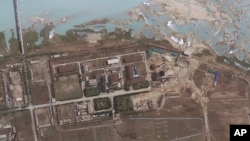The U.N. nuclear watchdog said it has seen releases of steam and water indicating that North Korea may be operating a reactor, in the latest update on a plant that experts say could make plutonium for atomic bombs.
North Korea announced in April of last year that it would revive its aged five-megawatt research reactor at the Yongbyon nuclear complex, saying it was seeking a deterrent capacity.
The isolated and poverty-stricken state defends its nuclear program as a "treasured sword" to counter what it sees as U.S.- led hostility.
In an annual report posted on it website, the Vienna-based International Atomic Energy Agency (IAEA) said North Korea's nuclear program "remains a matter of serious concern".
The U.N. agency said it continued to monitor developments at Yongbyon through satellite imagery.
"Since late August 2013, the Agency has observed, through analysis of satellite imagery, steam discharges and the outflow of cooling water at the 5 MW(e) reactor, signatures which are consistent with the reactor's operation," the IAEA said.
"However, since the agency has had no access to the 5 MW(e) reactor since April 2009, it cannot confirm the operational status of the reactor," it said.
North Korea expelled IAEA inspectors in 2009 and the agency has had no inspectors in the country since then.
The Yongbyon reactor has been technically out of operation for years. North Korea destroyed its cooling tower in 2008 as a confidence-building step in talks with South Korea, China, the United States, Japan and Russia.
When North Korea said it planned to revive it, experts said it would probably take about half a year to get it up and running, if it had not suffered significant damage from neglect.
U.S. Director of National Intelligence James Clapper issued an assessment in January saying that North Korea had expanded its uranium enrichment facility at Yongbyon and restarted the reactor there previously used for plutonium production.
The U.S. State Department called the moves "a significant step in the wrong direction" and contrary to North Korea's international commitments.
"These activities signal Pyongyang's clear lack of a genuine commitment to denuclearization," it said in a statement on Thursday.
Developing Nuclear Capabilities?
The U.S.-based Institute for Science and International Security (ISIS) said last month that commercial satellite imagery from late June showed that the reactor was active.
"North Korea has apparently made a decision to renovate the aged 5 MW(e) reactor to make plutonium for nuclear weapons for many more years," it said. "However, without more data, such as regular steam production, it is hard to determine the operational status of the reactor and thus to estimate the amount of plutonium produced by the reactor."
While North Korea has long boasted of making strides in acquiring a "nuclear deterrent", there had been general skepticism that it could master the step of miniaturizing a nuclear warhead to mount on a ballistic missile.
But there has been a shift in thinking since it conducted a nuclear test in February last year - its third since 2006 - and some experts have said it may be closer than previously thought to putting a nuclear warhead on a missile.
Yongbyon is also the site of other nuclear facilities and the IAEA said in its report that it had "observed ongoing renovation and new construction activities at various locations within" the complex.
"Although the purpose of such activities cannot be determined through satellite imagery alone, they appear to be broadly consistent with [North Korea's] statements that it is further developing its nuclear capabilities," it said.






